|
| Illustration of Standard - A Mature Schipperke |
|
|
| This Sketch is Copyrighted to the Owner - Do Not Remove! |
Breed Standard
Origin and Purpose: The Schipperke is thought to have originated in the Flemish Province of Belgium from the
native black sheep dogs now believed to be extinct, the Leauvennar, from which the Groendael Belgian Sheep Dog has also probably
evolved. The Schipperke may lay claim to being one of the oldest purebreds in Europe, for in 1690, a show for the Schipperkes
of the Guild Workmen was held in the Grand Place of Brussels. The Schipperke is an excellent and faithful little watchdog;
a hunter of moles and other vermin. He seeks the company of horses, can be used to hunt, and is a good rabbit dog.
General Appearance: The Schipperke should have a short, thick-set cobby body, with hindquarters slightly lighter
than the foreparts. The head is fox-like, and the expression is questioning, sharp and lively. Not mean or wild. The distinctive
black coat, ruff, and tailless rump give a unique silhouette to this small dog.
Temperament: The Schipperke is active, agile, indefatigable, and continually occupied with what is going on
around him. He is careful of things that are given to him to guard, very kind with children, and suspicious of strangers.
He knows the way of the household, is always curious of what is going on behind closed doors, or about any object that has
been moved, betraying his impressions by his sharp bark and upstanding ruff.
Size: 12 - 18 lbs. (5.5 - 8 kg's.)
Coat and Color: The coat must be black, abundant, and slightly harsh to the touch. Short on the ears, front
of the legs, and on the hocks, fairly short on the body, but longer around the neck, beginning back of the ears, and forming
a ruff and cape, which gives the appearance of the withers being higher than the hindquarters, and a jabot extending down
between the front legs. The coat is longer on the rear, where it forms a culotte, with the points turning inwards. The undercoat
is dense and short on the body, and very dense around the neck, making the ruff stand out. The culotte should be as long as
the ruff.
| Very Pretty Female |

|
| Lovely ear set |
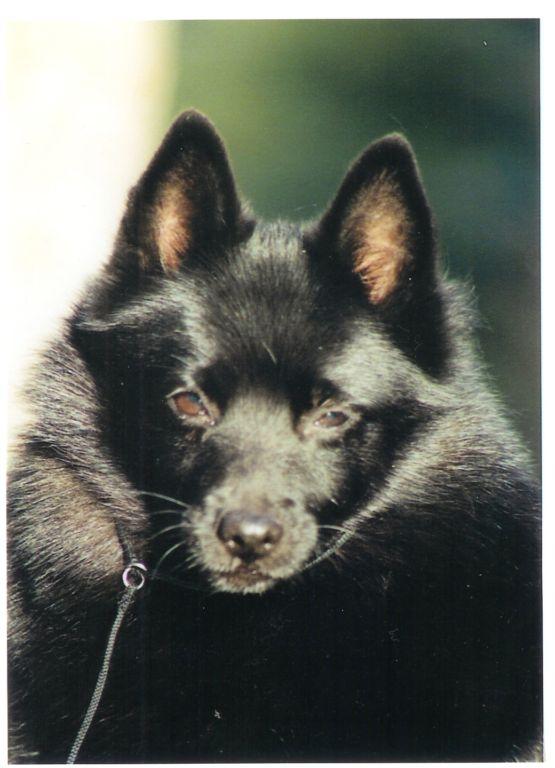
|
| male head |
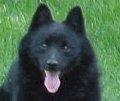
|
| Beautiful! |
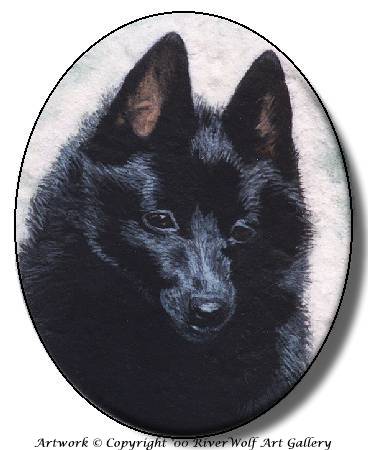
|
| Profile |
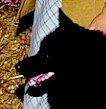
|
| Another lovely profile and neck |

|
| Domey toy head - Incorrect |
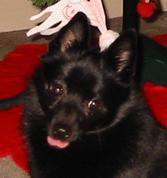
|
Head:
Skull: Fairly wide, narrowing at the eyes. When the ears are up in the alert position, the correct skull in
profile will appear flat.
Muzzle: Tapering, but not too much stop. The length of the muzzle from tip to stop is equal to the length of
the skull from the stop to the occiput.
Nose: Small and black.
Mouth: Teeth strong and even. A level or scissors bite is acceptable.
Eyes: Very dark brown, small, oval rather than round, neither sunken nor prominent.
Ears: Very erect, small and triangular, placed high. Strong enough not to be capable of being lowered except
in line with the body.
| LOVELY TYPEY FEMALE |
|
|
| 10 YRS OLD |
Neck: Strong and full, slightly arched.
Forequarters: Shoulders muscular and sloping. Legs straight and well under the body, with bone in proportion
to the body. Pasterns straight.
Body: Back strong, short, straight, and level. Chest broad and deep in the brisket, ribs well sprung, broad
behind the shoulders. Loin muscular and well drawn up from the brisket, but not to such an extent as to cause a weak and leggy
appearance of the hindquarters. Croup slightly sloping. Rump well rounded.
Hindquarters: Lighter than the foreparts, but muscular and powerful. Thighs muscular and powerful. Hocks well
defined. Metatarsus short. Feet small, round, and tight (not splayed). Nails straight, strong and short.
Tail: Docked to no more than 1 inch (3 cm's) in length.
Gait: Unrestricted, free and vigorous. The Schipperke is tireless and quick to move in any direction. In a correctly
proportioned and angulated Schipperke at a trot, the feet and legs converge as seen from the front or the rear, and each hind
foot falls on or ahead of the print of the forefoot.
Faults: Any deviation from the Standard is considered a fault.
Disqualifications: Any color other than solid black, drop or semi-erect ears, overshot or undershot mouth.
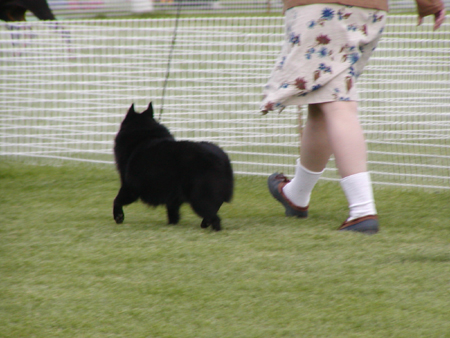
Illustration of the lifestages of a Show Schipperke
6 months - first show - group 2nd, Best puppy in Group
18 months - New Canadian Champion
3 years - BW at Am Specialty, New Am Ch.
5 years - BISS Cdn National Specialty Show.
this illustrates the stages your Schip may go through until it reaches full maturity by 5 years of age
| 6 Month Old Puppy |
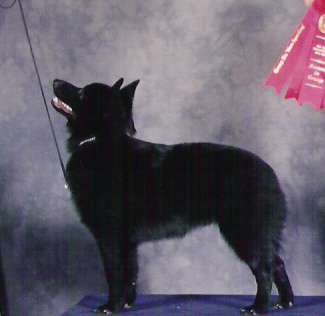
|
| Immature male 18 months |
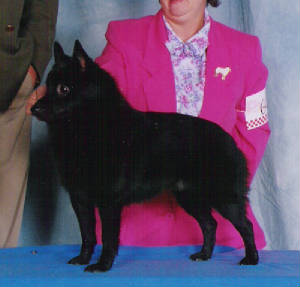
|
| 3 Years |
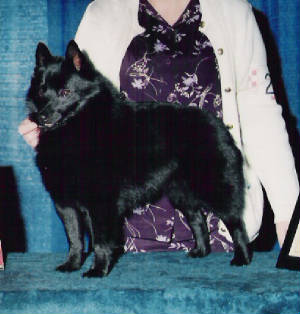
|
| 5 Years - Fully Mature |
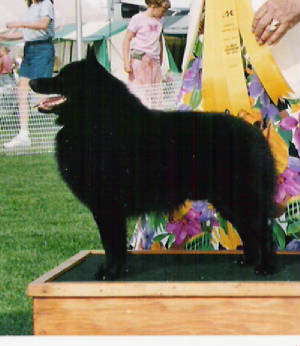
|

PEDIGREE INFORMATION ON SCHIPPERKES CAN BE FOUND AT BONCHIEN WEBSITE. MUCH THANKS TO KRISTEN HENRY FOR HER COUNTLESS
HOURS OF DEVOTION TO MAINTAINING THIS.
|

